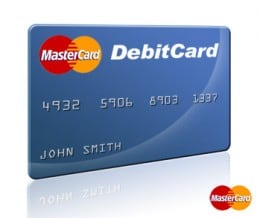Types of Debit Card Systems
There are currently three ways that debit card transactions are processed: online debit (also known as PIN debit), offline debit (also known as signature debit) and the Electronic Purse Card System. One physical card can include the functions of an online debit card, an offline debit card and an electronic purse card.
Although many debit cards are of the Visa or MasterCard brand, there are many other types of debit card, each accepted only within a particular country or region, for example Switch (now: Maestro) and Solo in the United Kingdom, Interac in Canada, Carte Bleue in France,Laser in Ireland, “EC electronic cash” (formerly Eurocheque) in Germany, UnionPay in China and EFTPOS cards in Australia and New Zealand. The need for cross-border compatibility and the advent of the euro recently led to many of these card networks (such asSwitzerland’s “EC direkt”, Austria’s “Bankomatkasse” and Switch in the United Kingdom) being re-branded with the internationally recognisedMaestro logo, which is part of the MasterCard brand. Some debit cards are dual branded with the logo of the (former) national card as well asMaestro (for example, EC cards in Germany, Laser cards in Ireland, Switch and Solo in the UK, Pinpas cards in the Netherlands, Bancontact cards in Belgium, etc.). The use of a debit card system allows operators to package their product more effectively while monitoring customer spending. An example of one of these systems is ECS by Embed International.
Online Debit System
Online debit cards require electronic authorization of every transaction and the debits are reflected in the user’s account immediately. The transaction may be additionally secured with the personal identification number (PIN) authentication system and some online cards require such authentication for every transaction, essentially becoming enhanced automatic teller machine (ATM) cards. One difficulty in using online debit cards is the necessity of an electronic authorization device at the point of sale (POS) and sometimes also a separate PINpad to enter the PIN, although this is becoming commonplace for all card transactions in many countries. Overall, the online debit card is generally viewed as superior to the offline debit card because of its more secure authentication system and live status, which alleviates problems with processing lag on transactions that may only issue online debit cards. Some on-line debit systems are using the normal authentication processes of Internet banking to provide real-time on-line debit transactions. The most notable of these are Ideal and POLl.
Offline Debit System
Offline debit cards have the logos of major credit cards (for example, Visa or MasterCard) or major debit cards (for example, Maestro in theUnited Kingdom and other countries, but not the United States) and are used at the point of sale like a credit card (with payer’s signature). This type of debit card may be subject to a daily limit, and/or a maximum limit equal to the current/checking account balance from which it draws funds. Transactions conducted with offline debit cards require 2–3 days to be reflected on users’ account balances.
In some countries and with some banks and merchant service organizations, a “credit” or offline debit transaction is without cost to the purchaser beyond the face value of the transaction, while a fee may be charged for a “debit” or online debit transaction (although it is often absorbed by the retailer). Other differences are that online debit purchasers may opt to withdraw cash in addition to the amount of the debit purchase (if the merchant supports that functionality); also, from the merchant’s standpoint, the merchant pays lower fees on online debit transaction as compared to “credit” (offline) debit transaction.
Electronic Purse Card System
Smart-card-based electronic purse systems (in which value is stored on the card chip, not in an externally recorded account, so that machines accepting the card need no network connectivity) are in use throughout Europe since the mid-1990s, most notably in Germany (Geldkarte), Austria (Quick Wertkarte), the Netherlands (Chipknip), Belgium (Proton), Switzerland (CASH) and France (Mon€o, which is usually carried by a debit card). In Austria and Germany, all current bank cards now include electronic purses.
Prepaid debit cards, also called reloadable debit cards, appeal to a variety of users. The primary market for prepaid cards are unbanked people, an umbrella term used to describe diverse groups of individuals- typically with poor credit ratings- who do not use banks or credit unions for their financial transactions.
The advantages of prepaid debit cards include being safer than carry cash, worldwide functionality due to Visa and MasterCard merchant acceptance, not having to worry about paying a credit card bill or going into debt, the ability for anyone over the age of 18 to apply and be accepted without regard to credit quality and the ability to direct deposit paychecks and government benefits onto the card for free.
Some of the first companies to enter this market were MiCash, RushCard and Netspend who gained high market share as a result of being first to market. However, in the past few years there have been several new providers that carry a number of other benefits, such as money remittance service, card-to-card transfers and the ability to apply without a social security number.


